Yesterday I volunteered to be a member of the emergency communications team for the 2017 Mt. Washington Bicycle Hill Climb. It’s an annual event done in conjunction with the private Mt. Washington Auto Road and the Tin Mountain Conservation Center. Cycle professionals and enthusiasts do whatever is necessary to gain 4,875 feet in elevation in as little time as possible.
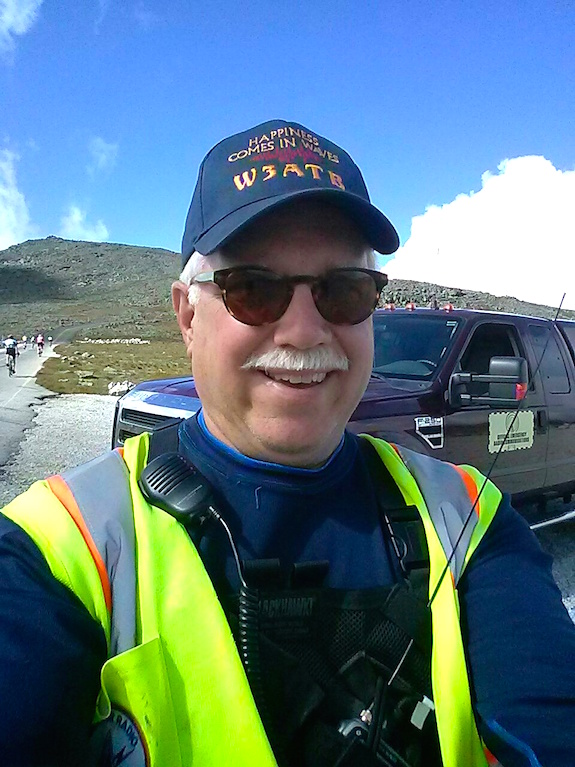
This is an odd selfie shot. My head is tilted down giving me a horrible triple chin because I wanted you to see the words on my hat. Copyright 2017 Tim Carter
This year’s winning time was an astonishing 51 minutes and 13 seconds by Phil Gaimon. The winning woman rider was Aimee Vasse with a time of 1:05:34.
I’ve worked many times on the Rock Pile as it’s called by all the locals. Many don’t realize the history behind the name because they don’t pay close attention as they ascend the mountain.
As you claw your way up the serpentine 7.2 mile road with no guardrails you see nothing but raw bedrock for miles and miles. But as you get up to the strange flat eight-acre cow pasture at the 5,700-foot elevation you start to notice that the mountain is comprised of jumbled rocks and no solid bedrock is exposed.
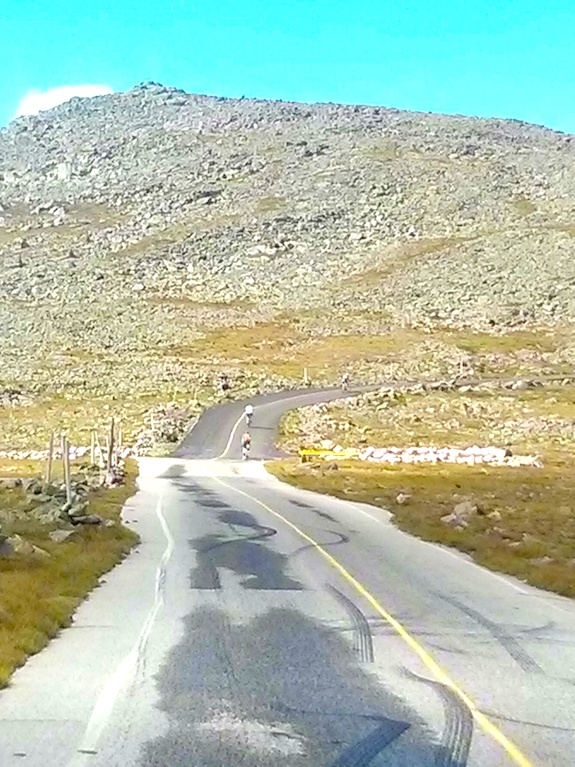
This photo is looking due southwest at a mound of jumbled rocks some as large as cars. Underneath it at some depth is bedrock. I was standing in the cow pasture that’s about 5,700 feet in elevation. It’s a lower quality photo using the digital zoom feature of my cellphone. Copyright 2017 Tim Carter
The massive gigantic continental glaciers that covered all of New England just 15,000 years ago weren’t thick enough to scour the rocks off the tip of Mt. Washington. Normal weathering over hundreds of thousands of years has created a collection of rocks that are slowly being broken down and carried to the oceans.
Mother Nature will expose the bedrock under the rocks, but she’s taking her time doing it.
The day before the event we received three inches of rain at my house which is about 60 miles south of Mt. Washington. As I left my house at 5:20 am, it was still dark but you could feel the atmosphere was choked with moisture.

This is what I drove through for much of the 1-hour 45-minute drive from my home. This photo was taken on State Route 16 just below Pinkham Notch as the road runs next to the base of Mt. Washington. Copyright 2017 Tim Carter
As dawn broke, I drove through fog and leaden skies. No doubt it was going to be a changing weather day up on the mountain. I just hoped for moderate wind.
After the top three male and female riders passed me, my work was done for the day. The only other thing I’d have to do is call in for emergency medical help for a rider near my position.
I decided to pass the time using my elevation to my advantage. I set one side of my Yaseu mobile radio in my truck to the national calling frequency of 146.52 MHz. I was booming out at 50 watts and had line of vision sight to the north of over 200 miles.
It didn’t take long to have at least four or five operators come back to me who were up in Maine. At one point I called, “CQ CQ this is W3ATB atop Mt. Washington.”
A second later I heard, “W1PID”.
What? No way! That’s my very close friend Jim Cluett. It turns out he was driving down in Laconia, NH on his way to help our friend Dick Christopher, N1LT with his sailboat. The tip of my truck antenna was higher than the ground to the south of where I was parked and I was able to talk with anyone in that direction.
After talking with Jim, I then logged two contacts with operators at light houses along the coast. It turns out it was the International Lighthouse and Lightship Weekend and lighthouses all over the world had radio operators in or next to them trying to make contact. Here’s my log for those two contacts:
| WS1SM | 146.520 MHz | 1555 UTC |
| K1N | 146.520 MHz | 1610 UTC |
K1N was operating at the Newburyport, MA harbor light on Plum Island. How exciting! It was a fun day of radio for me to say the very least.
I vote we let photos tell the rest of the story. They do so much better if you ask me.
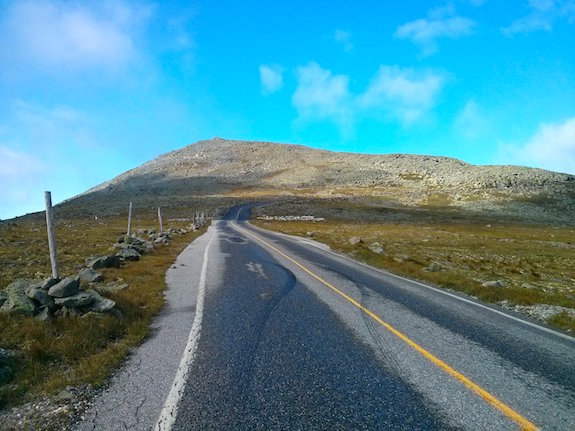
This is one of the selfish reasons why I volunteer for these events. I get to drive up the mountain early and get set up. It’s just me and the mountain. It can be very spiritual as you feel quite alone. That is NOT the summit of Mt. Washington. If you were to hike to the top of that false summit, you’d clearly see the summit building just 500 yards away. Copyright 2017 Tim Carter.
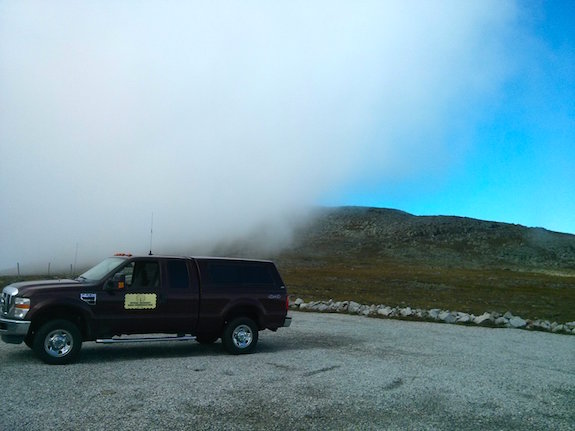
You’re up so high that clouds slither over you. It’s surreal when it happens. Within seconds of snapping this photo, I was surrounded by the soft cloud. Minutes later it had moved to the north and it was clear once more. Copyright 2017 Tim Carter
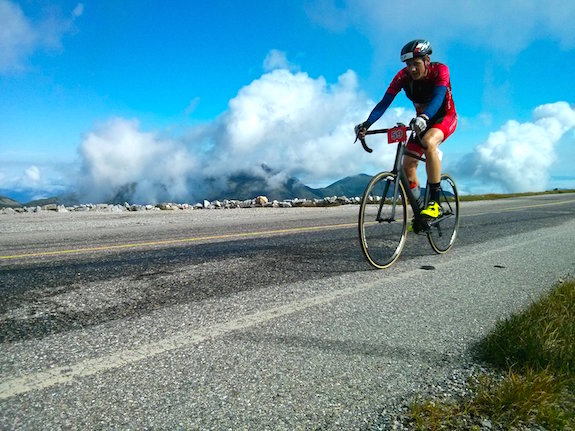
I’m aimed due north in this photo looking across the cow pasture directly at the distinguished Presidential Range of the White Mountains. Copyright 2017 Tim Carter
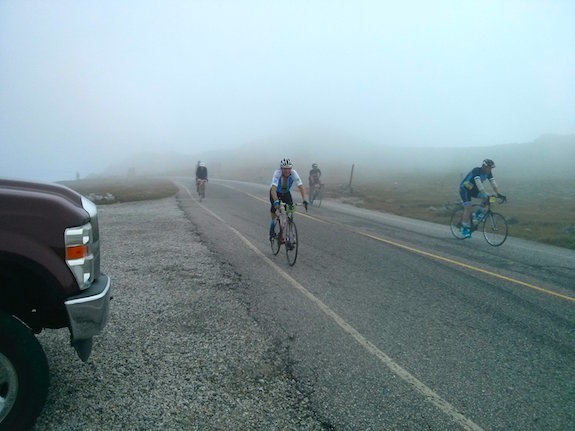
The clouds buffeted the mountain throughout the race. Most of the time it was so sunny and clear the sky was so blue it hurt your eyes to look at it. Copyright 2017 Tim Carter
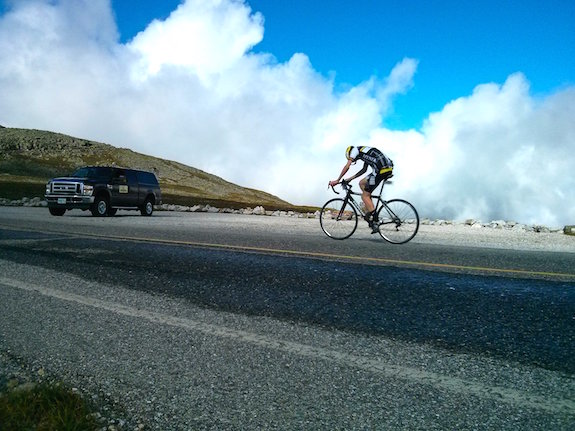
This rider is focused on the road. I found many looked down and my guess is they didn’t want to get distracted by how much higher they had to climb. This photo is taken looking northeast across the cow pasture. Copyright 2017 Tim Carter
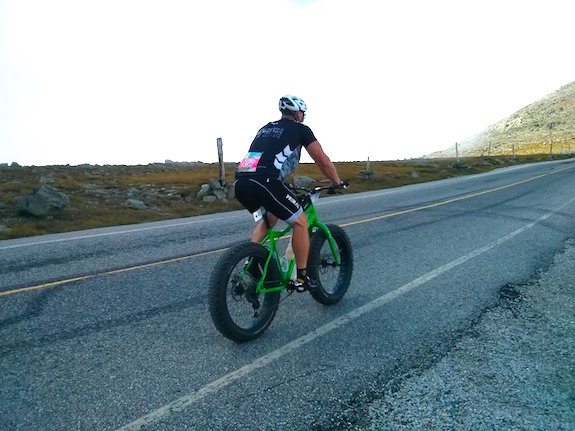
I did pay attention in my high school and college physics classes. I know that friction is the last thing you want when trying to carry yourself and the weight of a bicycle up over 4,875 in elevation! These fat tires would not have been my choice. He was the only one with this configuration. All the elite riders had tires thinner than someone who’s been in a life raft at sea for a month with no food. Copyright 2017 Tim Carter
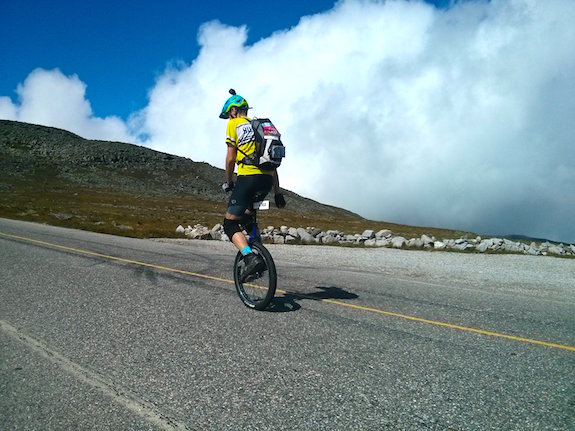
You may be surprised to see a unicyclist competing in this race. I’ve seen several over the years. But you should be in awe because it requires far more energy to be expended. It’s harder to balance yourself and note there’s NO GEARING to help with the task of going up hill for miles and miles. Copyright 2017 Tim Carter
